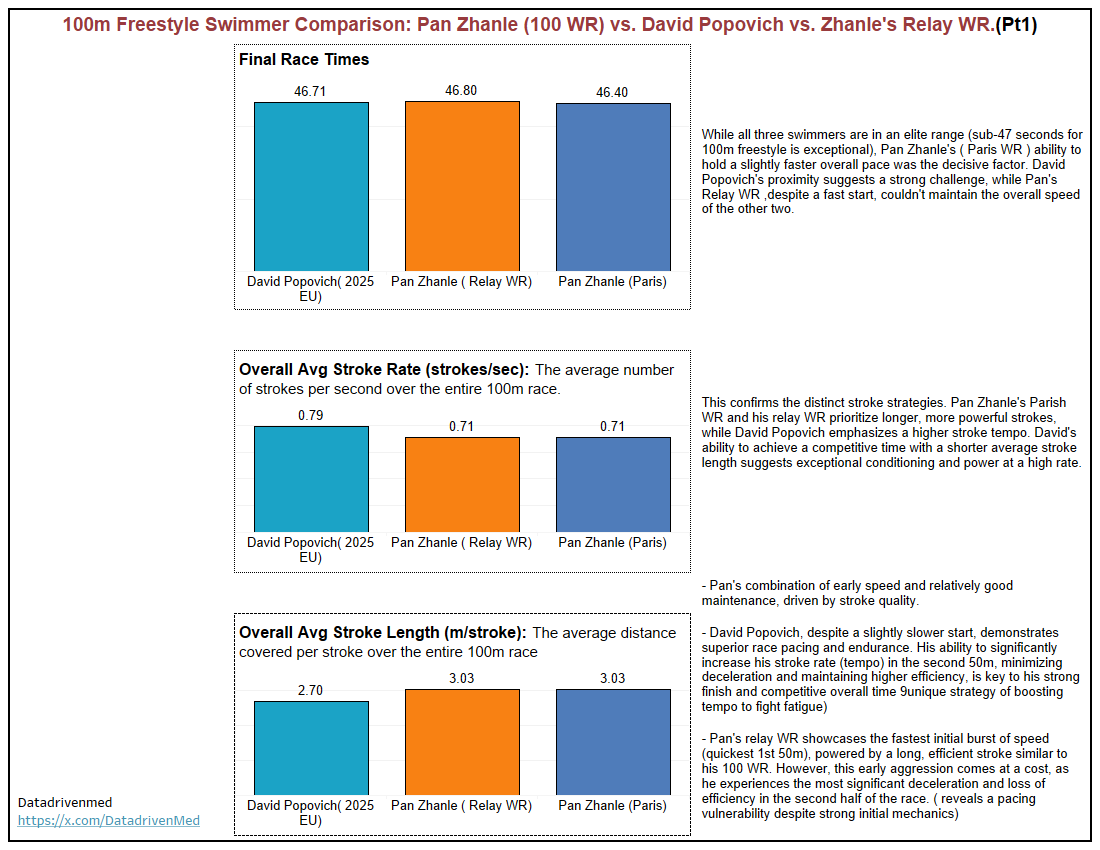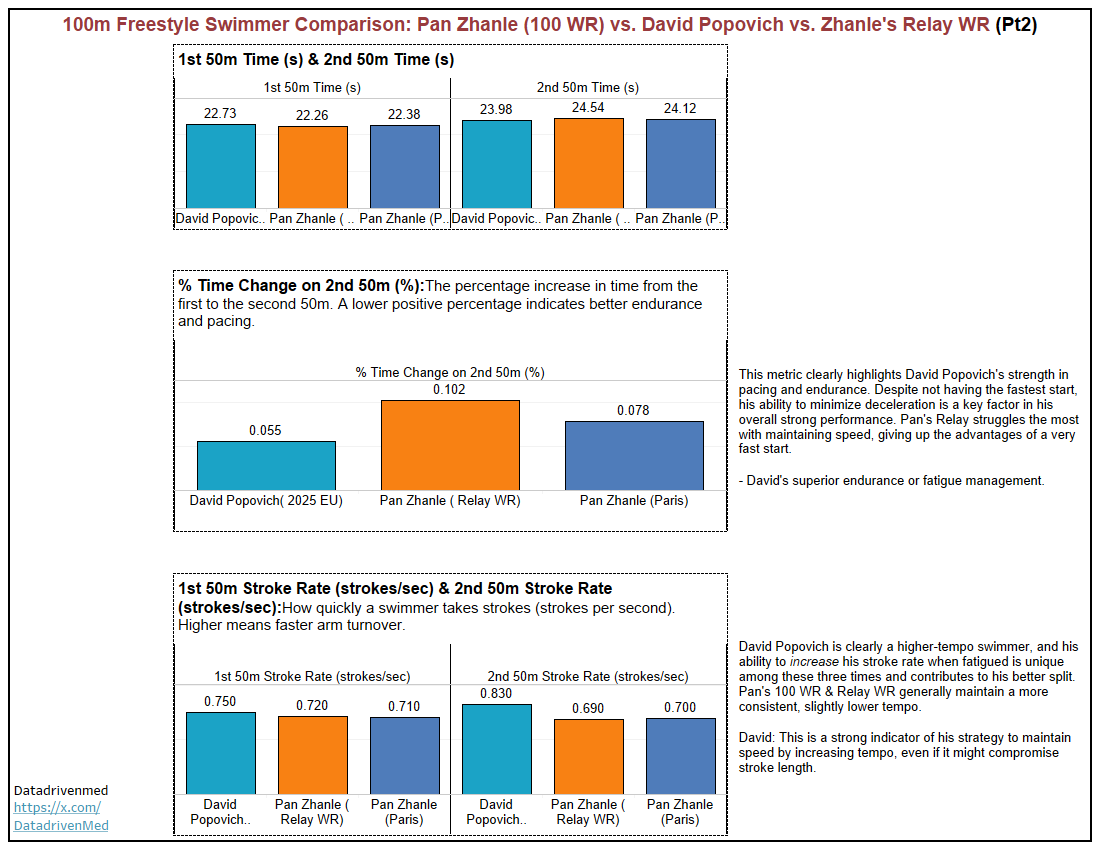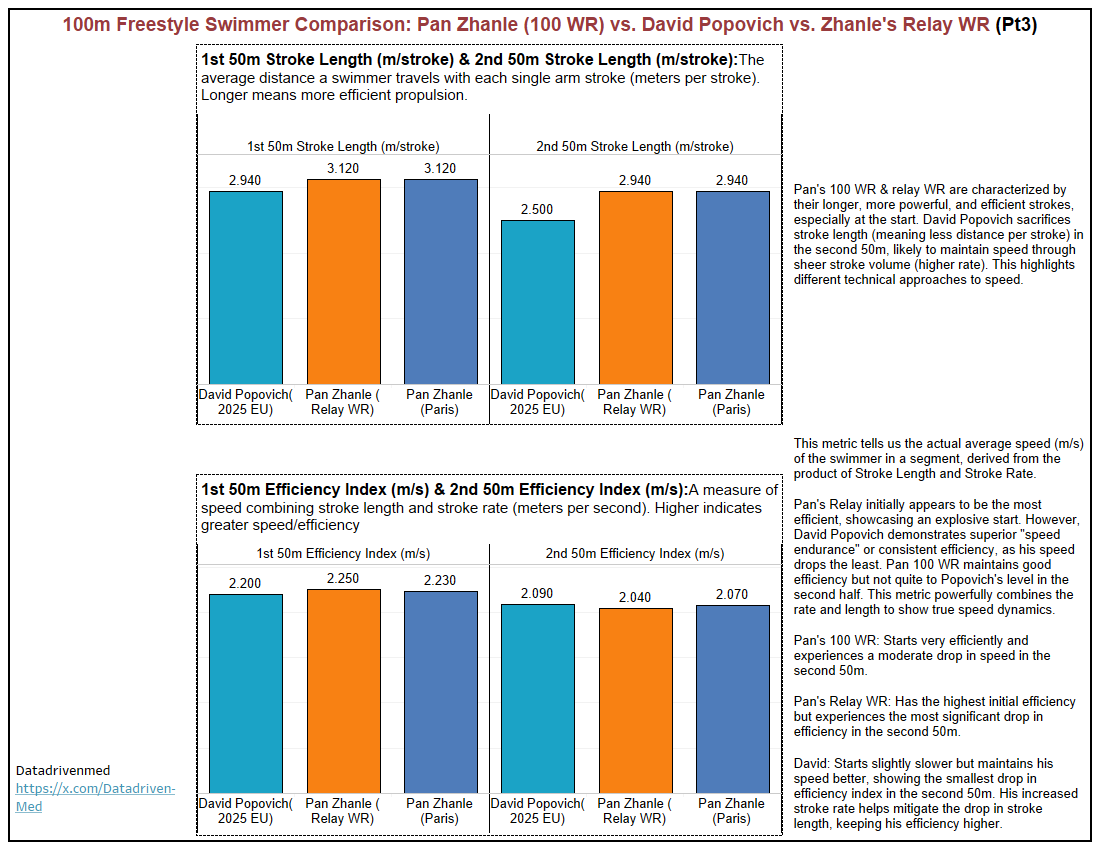In the world of elite swimming, every hundredth of a second counts. But what truly separates a world record from a personal best? It's not just raw speed; it's the intricate dance of pacing, stroke mechanics, and fatigue management.
Today, I'm pulling back the curtain on three exceptional 100m freestyle performances: Pan Zhanle (100 WR), David Popovich, and Pan Zhanle (Relay WR). I’ve meticulously analyzed their races, breaking down crucial metrics to offer unparalleled insights into sprint swimming.
I've distilled this analysis into three powerful infographics that you can explore below. Let's dive into what makes each swimmer's performance unique.
The Race for Gold: Final Times & Overall Strategies
At first glance, the final times tell the story: Pan Zhanle (100 WR) claimed the fastest overall time, a testament to world-record-breaking execution. David Popovich, incredibly close, showcases the fierce competition at the top.
But what truly defines their approach?
* Pan Zhanle (100 WR) and Pan Zhanle (Relay WR) exhibit similar overall average stroke rates and lengths. This points to a shared strategy emphasizing powerful, efficient strokes that maximize distance per pull.
* David Popovich, in contrast, operates with a noticeably higher overall average stroke rate and a shorter stroke length. This reveals a distinct strategic choice: he achieves speed through higher tempo and arm turnover. His ability to remain competitive with this style speaks volumes about his conditioning and power at a high frequency.
The Pacing Puzzle: Splits & Fatigue Management
The 50m split times and, critically, the percentage change on the second 50m reveal the true heroes of pacing.
* While Pan Zhanle (Relay WR) explodes with the fastest first 50m, his momentum proves hardest to maintain, showing the highest percentage time increase in the second half. This highlights a common sprint challenge: managing that early burst.
* Pan Zhanle (100 WR) executes a strong first 50m but still experiences a moderate slowdown.
* David Popovich stands out for his superior endurance and fatigue management. Despite not having the fastest start, his remarkably low percentage time change on the second 50m is a strong indicator of his strategic prowess in maintaining speed under pressure. This is a critical factor in his overall strong performance.
The Stroke Rate data further explains this: David Popovich is a clear high-tempo swimmer who not only starts with a higher rate but increases his stroke rate in the second 50m. This is a rare and powerful adaptation, allowing him to fight deceleration by boosting his turnover, even if it might compromise his stroke length slightly. Pan Zhanle (100 WR) and Pan Zhanle (Relay WR) generally maintain a more consistent, slightly lower tempo.
The Mechanics of Speed: Stroke Length & Efficiency
Finally, I look at the intricate details of their propulsion.
* Pan Zhanle (100 WR) and Pan Zhanle (Relay WR) exemplify efficiency, starting with impressive stroke lengths that allow them to cover more distance per pull. While they experience a drop in stroke length in the second 50m (a common effect of fatigue), their foundation is built on powerful, extended strokes.
* David Popovich, consistent with his higher stroke rate, operates with a shorter stroke length from the start, and experiences a more pronounced sacrifice of stroke length in the second 50m. This is the trade-off for his increased tempo, as he relies on sheer volume of strokes rather than maximal glide per stroke to maintain speed.
The Efficiency Index (Speed) brings it all together:
* While Pan Zhanle (Relay WR) initially boasts the highest efficiency (fastest early speed), his efficiency drops the most in the second 50m.
* Pan Zhanle (100 WR) maintains solid efficiency throughout but sees a moderate decrease.
* David Popovich shows exceptional "speed endurance." Despite not having the highest initial efficiency, his efficiency drops the least in the second 50m. This metric powerfully reveals how his increased stroke rate helps mitigate the drop in his stroke length, allowing him to maintain higher overall speed and consistency.
Key Takeaways for Coaches & Swimmers:
This detailed analysis underscores that there isn't one single "perfect" way to swim fast.
* Pacing is Paramount: Minimizing deceleration in the second half, as demonstrated by David Popovich, can be more impactful than just having an explosive start.
* Adaptability is King: David Popovich's ability to adjust his stroke mechanics (increasing rate) under fatigue provides a powerful lesson in race strategy.
* Know Your Strengths: Whether it's brute power and long strokes (Pan Zhanle) or high tempo and endurance (David Popovich), understanding and optimizing your individual profile is key.
What insights did you gain from these infographics? Share your thoughts in the comments below!
Don't forget to subscribe for more in-depth sports analytics!






